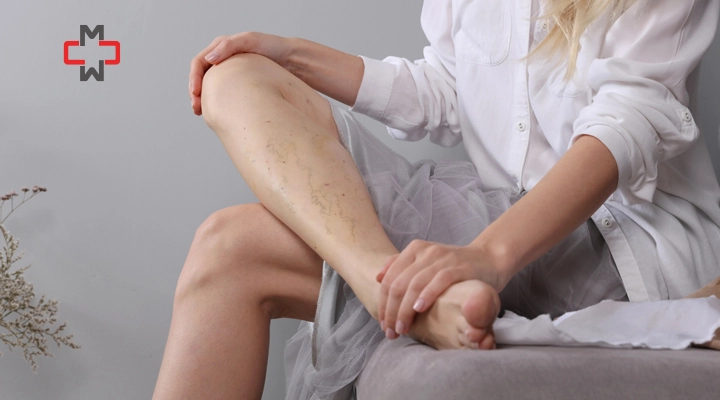Have you ever noticed those twisted, bulging veins on your legs and wondered if you should be concerned?
Varicose veins are a common condition that affects millions of people worldwide. While they are often considered a cosmetic issue, they can at times signal much more serious health problems.
Understanding when to worry about varicose veins is crucial for maintaining overall health and well-being.
What Are Varicose Veins?
These are enlarged, swollen varicose veins that often appear blue or dark purple and are commonly found on the legs and feet. They occur when the valves within the veins malfunction, causing blood to flow backward and pool, leading to vein enlargement. While swollen varicose veins are typically benign, they can cause discomfort, pain, and in some cases, more serious complications.
Types of Varicose Veins
There are several types of varicose veins, each with distinct characteristics:
- Trunk Varicose Veins: These are the large, swollen varicose veins that are visible just under the skin’s surface. They often appear lumpy and twisted and are typically found on the legs.
- Reticular Varicose Veins: Smaller than trunk varicose veins, reticular veins are red or blue and can form a network of veins, usually on the legs and behind the knees.
- Telangiectasias (Spider Veins): These are very small, thin veins that are close to the surface of the skin and appear red or blue. They often form web-like patterns and can occur on the legs, face, or other parts of the body.
Causes of Varicose Veins
Varicose veins can develop due to several factors:
- Genetics: A family history of varicose veins increases your risk of developing the condition.
- Age: As you age, veins lose elasticity, and the valves within them may weaken, leading to varicose veins.
- Gender: Women are more likely to develop varicose veins due to hormonal changes during pregnancy, menopause, and menstrual cycles.
- Pregnancy: Increased blood volume and hormonal changes during pregnancy can lead to varicose veins.
- Obesity: Excess weight puts additional pressure on veins, which can contribute to the development of swollen varicose veins.
- Prolonged Standing or Sitting: Occupations that require long periods of standing or sitting can increase the risk of varicose veins due to reduced blood circulation.
When To Worry About Varicose Veins?
While varicose veins are often a cosmetic concern, certain symptoms and signs indicate the need for medical attention:
- Severe Pain or Discomfort: If varicose veins cause significant pain, or you experience burning veins, it could be a sign of underlying issues.
- Swelling: Persistent swelling in the legs and ankles may indicate poor circulation or other complications.
- Skin Changes: Changes in skin color, thickness, or the development of ulcers near the ankle area are warning signs.
- Bleeding: Varicose veins close to the surface of the skin can sometimes rupture, leading to bleeding.
- Blood Clots: If a varicose vein becomes hard, swollen, or extremely tender, it could indicate a blood clot, which requires immediate medical attention.
Risk Factors and Prevention
Certain factors can increase your risk of developing varicose veins. Understanding these risks and taking the required preventive measures can help manage or reduce their occurrence:
- Age: Older age increases the risk.
- Gender: Women are more prone to hormonal influences.
- Family History: A genetic predisposition can play a significant role.
- Obesity: Maintaining a healthy weight through diet and exercise can reduce pressure on veins.
- Physical Activity: Regular exercise improves leg strength and circulation.
- Avoid Prolonged Standing or Sitting: Taking breaks to move around can improve blood flow.
- Compression Stockings: Wearing compression stockings can help prevent blood from pooling in the veins.
How To Treat Varicose Veins?
Several treatment options are available to help you manage swollen varicose veins:
- Lifestyle Changes: Regular exercise, maintaining a healthy weight, and avoiding prolonged standing or sitting can help manage symptoms.
- Compression Stockings: These specially designed stockings apply pressure to the legs, helping veins move blood more efficiently.
- Sclerotherapy: This involves injecting a solution into the vein that causes it to collapse and fade away.
- Laser Treatments: Laser treatments use light energy to close off varicose veins.
- Radiofrequency Ablation: This technique uses radiofrequency energy to heat and close off affected veins.
- Vein Stripping: A surgical procedure to remove larger varicose veins.
- Endovenous Laser Treatment (EVLT): A minimally invasive procedure using laser energy to seal off varicose veins.
Frequently Asked Questions
Are varicose veins dangerous?
Varicose veins are usually not dangerous, but they can sometimes lead to more serious health problems like ulcers, bleeding, and blood clots if left untreated.
When do varicose veins become serious?
Varicose veins become serious if you experience severe pain, burning veins, persistent swelling, skin changes, ulcers, or signs of a blood clot such as a hard, swollen, and tender vein.
How do I know if I have a blood clot in my varicose vein?
If you have a blood clot in your varicose vein, you may notice the vein becoming hard, swollen, red, and extremely tender. Seek medical attention immediately if you suspect a blood clot.
Is it OK to leave varicose veins untreated?
While some people may not experience significant issues, untreated varicose veins can lead to complications such as chronic pain, swelling, skin ulcers, and an increased risk of blood clots.
What's the worst that can happen with varicose veins?
The worst complications from swollen varicose veins include severe skin ulcers, deep vein thrombosis (a serious blood clot), and significant bleeding from ruptured veins. These conditions require medical intervention.
– Disclaimer –
This blog is for informational & educational purposes only and does not intend to substitute any professional medical advice or consultation. For any health-related concerns, please consult with your physician, or call 911.
-
About The Author
Dr. Syra Hanif M.D.Board Certified Primary Care Physician
Dr. Syra Hanif is a board-certified Primary Care Physician (PCP) dedicated to providing compassionate, patient-centered healthcare.
Read More







